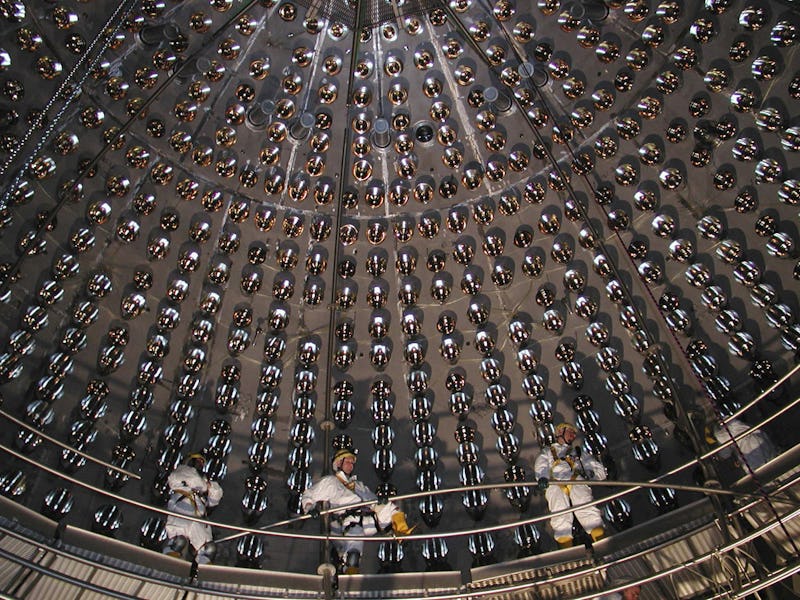How Much Fuel Does Earth Have Left in Its Tank?
We can find out with one seriously finicky experiment.

Our planet gets much of its energy from the Sun, but some of Earth’s most crucial natural phenomena — like plate tectonics and the magnetic field — rely on fuel stored up deep within the Earth’s interior. And while geologists have long estimated just how much of that fuel is left to keep our planet running, the reality is that we don’t actually have any real idea how much we have left. But now, thanks to a seriously nifty experiment involving antineutrinos, we might have an answer within a decade.
When we talk about the planet’s fuel, we’re not dealing with fossil fuels or other materials that humans extract and burn for energy. Instead, we’re dealing with something much more fundamental, a mix of primordial energy from the Earth’s formation and nuclear energy generated by the decay of radioactive elements. Knowing how much Earth has left will clarify basic questions about how our planet works.
“We can have a simple perspective — we need to know if we are ‘running on empty’ or we have plenty of fuel to drive the Earth’s engine,” William McDonough, a geologist at the University of Maryland and part of the researchers looking to measure Earth’s fuel supply, told Inverse. “About 150 years ago people were asking how long will the sun shine. This led to questions about the details of the shining process (i.e., nuclear burning in the core of the Sun). It also led to similar fundamental curiosities about the Earth.”
The actual method involved here is finicky to the extreme. The plan is to measure particles called geoneutrinos, a special kind of antineutrino emitted by the decay of radioactive elements like uranium and thorium. When those geoneutrinos collide with a hydrogen atom in a detector, a telltale signature lets the researchers compile all the events and estimate the rate of radioactive decay inside the Earth, which in turn would let them estimate Earth’s fuel supply.
“Zero detected events per year was my life before 2005.”
That’s all well and good, but subatomic particles as tiny and weakly interacting as geoneutrinos aren’t easily spotted. You need a detector the size of a small building buried a mile underground to shield it from cosmic neutrinos that would mess up the measurements. Even then, we only average about 16 sightings each year with current detectors. Again, finicky to the extreme, and even 16 a year is an improvement on how things used to be.
“Zero detected events per year was my life before 2005,” said McDonough. But the number is about to jump in a big way, as three massive new detectors in China and Canada are expected to push the number of annual detections above 500. A few years’ worth of data would mean potentially thousands of data points, more than enough for researchers to start feeling confident about the rate of thorium and uranium decay. “These experiments lasts for a decade or decades and so we are increasing our number of observations by 1000+ every two years! That’s what counts.”
This is the sort of thing that, once discovered, we’ll find it amazing that we never knew it in the first place
There’s a lot of good fundamental science to be done here, as McDonough and his fellow researchers hope to be able to explore big questions about the Earth’s billion-year story, how fast it burns through its fuel and how much is left. The answers the researchers hope to discover could also have more immediate benefits.
“We can make superior predictions about economic resources and where are the elements in the Earth,” McDonough told Inverse. “How much uranium do we have in the Earth to fuel nuclear power plants? How much niobium, lithium and/or lanthanum is there in the Earth? These are all elements that we are commonly depending on these days. We use the elements to create energy, to power our laptops, to make our GPS chips work, to make our batteries for our hybrid cars.”
That last example actually provides a good analogy for what McDonough and his fellow researchers are hoping to accomplish. Though detecting geoneutrinos isn’t easy work, it’s very necessary if we want to find out how much Earth has left in its proverbial tank. That’s something basic about how our planet works, the sort of thing that, once discovered, we’ll find it amazing that we never knew it in the first place.
“It is like a car driver,” said McDonough. “He/she know two important things about her/his car — how much fuel is left and how fast has he/she been using up their fuel. It is a simple request we have about what’s inside mother-ship Earth’s tank and how fast have we been using it.”